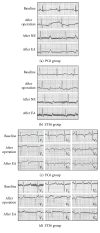Comparison of the Therapeutic Effects of Acupuncture at PC6 and ST36 for Chronic Myocardial Ischemia
- PMID: 28900462
- PMCID: PMC5576407
- DOI: 10.1155/2017/7358059
Comparison of the Therapeutic Effects of Acupuncture at PC6 and ST36 for Chronic Myocardial Ischemia
Abstract
We aimed to compare the differences of the effects on chronic myocardial ischemia (MI) of acupuncture at PC6 and ST36. The chronic MI model of minipigs was created by implanting an Ameroid constrictor on the left anterior descending coronary artery (LAD) and then two weeks' acupuncture was stimulated at PC6 or ST36, respectively. The results showed that both acupoints' stimulation decreased the serous cardiac troponin T (cTnT) and ischemia modified albumin (IMA) significantly and improved the ischemic ECG changes. The amplitude of pathological Q wave in the PC6 group decreased more significantly than that of the ST36 group. The cardiovascular magnetic resonance imaging (cMRI) results showed that the decreased left ventricular ejection fraction (LVEF) was not improved obviously in both groups. The left ventricular end-diastolic volume (LVEDV) and left ventricular end-systolic volume (LVESV) enlarged progressively even after acupuncture. The left ventricular wall mass (LVWM) in the ST36 group increased more obviously than that of the PC6 group, which paralleled the decreasing angiotensin II (Ang II) concentration in the plasma. These results suggested that acupuncture at PC6 or ST36 was effective for protecting the myocardium from chronic ischemic injury, and the effect of PC6 seemed to be better.
Figures





Similar articles
-
The Beneficial Effects of Electroacupuncture at PC6 Acupoints (Neiguan) on Myocardial Ischemia in ASIC3 -/- mice.J Acupunct Meridian Stud. 2018 Jun;11(3):88-96. doi: 10.1016/j.jams.2018.03.002. Epub 2018 Mar 31. J Acupunct Meridian Stud. 2018. PMID: 29608997
-
[Electroacupuncture at "Neiguan"(PC6) decreased cardiac sympathetic hyperactivity and improved cardiac function in chronic myocardial ischemia model rats].Zhen Ci Yan Jiu. 2020 Apr 25;45(4):264-8. doi: 10.13702/j.1000-0607.190942. Zhen Ci Yan Jiu. 2020. PMID: 32333529 Chinese.
-
Full-length transcriptome analysis reveals the mechanism of acupuncture at PC6 improves cardiac function in myocardial ischemia model.Chin Med. 2021 Jul 8;16(1):55. doi: 10.1186/s13020-021-00465-8. Chin Med. 2021. PMID: 34238326 Free PMC article.
-
Recent advances in the diagnosis and treatment of acute myocardial infarction.World J Cardiol. 2015 May 26;7(5):243-76. doi: 10.4330/wjc.v7.i5.243. World J Cardiol. 2015. PMID: 26015857 Free PMC article. Review.
-
Functional magnetic resonance imaging studies of acupuncture at ST36: a coordinate-based meta-analysis.Front Neurosci. 2023 Jun 9;17:1180434. doi: 10.3389/fnins.2023.1180434. eCollection 2023. Front Neurosci. 2023. PMID: 37360179 Free PMC article. Review.
Cited by
-
Comparative Study of Different Acupoints for Treating Acute Myocardial Ischemia in Mice.J Cardiovasc Transl Res. 2023 Jun;16(3):644-661. doi: 10.1007/s12265-022-10346-6. Epub 2023 Jan 23. J Cardiovasc Transl Res. 2023. PMID: 36689154 Free PMC article.
-
Antihypertensive and Antifibrosis Effects of Acupuncture at PC6 Acupoints in Spontaneously Hypertensive Rats and the Underlying Mechanisms.Front Physiol. 2020 Aug 26;11:734. doi: 10.3389/fphys.2020.00734. eCollection 2020. Front Physiol. 2020. PMID: 32982761 Free PMC article.
-
Clinical Events Associated with Acupuncture Intervention for the Treatment of Chronic Inflammation Associated Disorders.Mediators Inflamm. 2020 Jun 27;2020:2675785. doi: 10.1155/2020/2675785. eCollection 2020. Mediators Inflamm. 2020. PMID: 32684832 Free PMC article. Review.
-
Cardioprotective effect of transcutaneous electrical acupuncture point stimulation on perioperative elderly patients with coronary heart disease: a prospective, randomized, controlled clinical trial.Clin Interv Aging. 2019 Sep 6;14:1607-1614. doi: 10.2147/CIA.S210751. eCollection 2019. Clin Interv Aging. 2019. PMID: 31564843 Free PMC article. Clinical Trial.
-
Epigenetic Mechanisms of Angiogenesis in the Ischemic Heart Diseases with Acupuncture Treatment.Med Acupunct. 2020 Dec 1;32(6):381-384. doi: 10.1089/acu.2020.1487. Epub 2020 Dec 16. Med Acupunct. 2020. PMID: 33362892 Free PMC article.
References
-
- Lemos P. A., Hoye A., Serruys P. W. Recurrent angina after revascularization: An emerging problem for the clinician. Coronary Artery Disease. 2004;15(1):S11–S15. - PubMed
-
- Li X., Cao J., Jiang A. Clinical observation and dynamic electrocardiogram of unstable angina pectoris treated with acupuncture combined with western medication. Chinese Acupuncture & Moxibustion. 2015;35(9):895–896. - PubMed
LinkOut - more resources
Full Text Sources
Other Literature Sources
Research Materials
Miscellaneous

